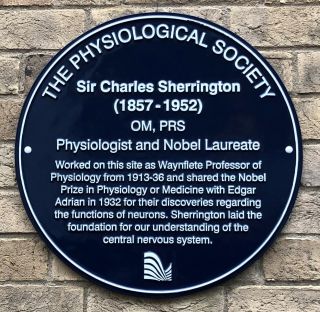The Physiological Society has mounted two blue plaque on the front entrance of the Sherrington Building in honour of Sir Charles Sherrington FRS (1857-1952) and Florence Buchanan (1867 - 1931).

Sherrington received the Nobel Prize in Physiology or Medicine in 1932 with Edgar Adrian for their work on the functions of neurons. Prior to the work of Sherrington and Adrian, it was widely accepted that reflexes occurred as isolated activity within a reflex arc; instead Sherrington and Adrian showed that reflexes require integrated activation and demonstrated reciprocal innervation of muscles, a principle now known as Sherrington's Law.

She worked with John Burdon-Sanderson in the Laboratory of Physiology on the electrical responses of muscle from 1894 - 1904. University College awarded Florence a DSc in Physiology in 1902 in recognition of this work. She set up her own lab at the Oxford University Museum of Natural History from 1904 - 1913.
Buchanan was the first woman to attend a meeting of The Physiological Society in 1896. In 1912, she became the first woman proposed to become a member of The Society, and was formally admitted in 1915. By then she had given at least 10 communications to the Society, published 2 papers in The Journal of Physiology and 3 in what is now Experimental Physiology.
Read the full story on the Department of Physiology, Anatomy & Genetics (DPAG) website

